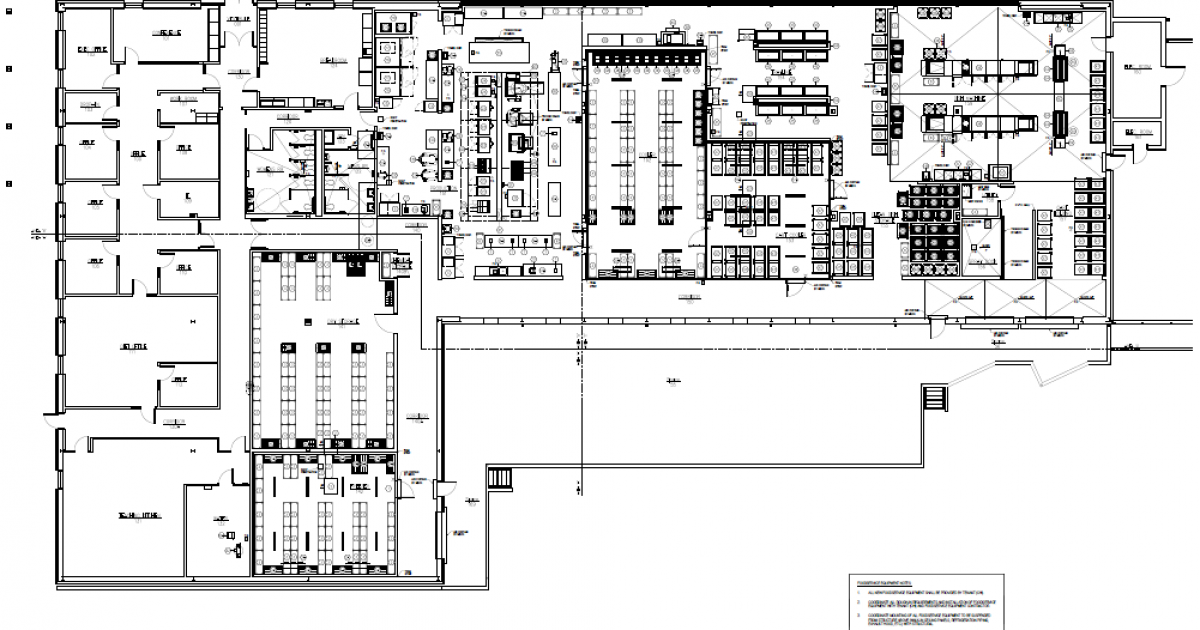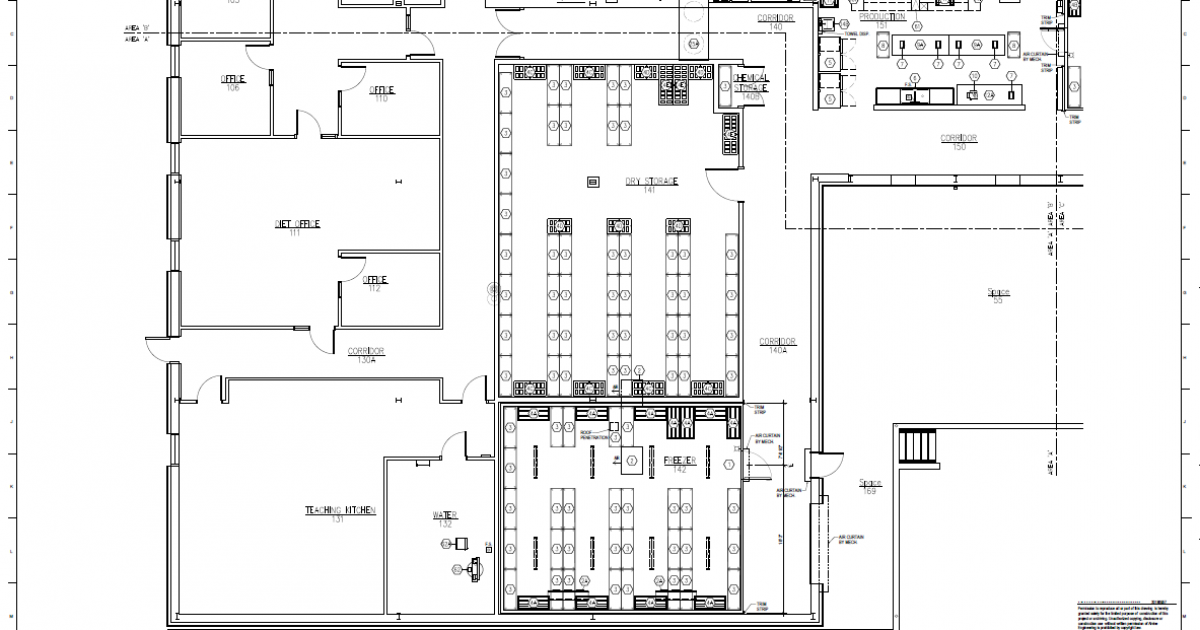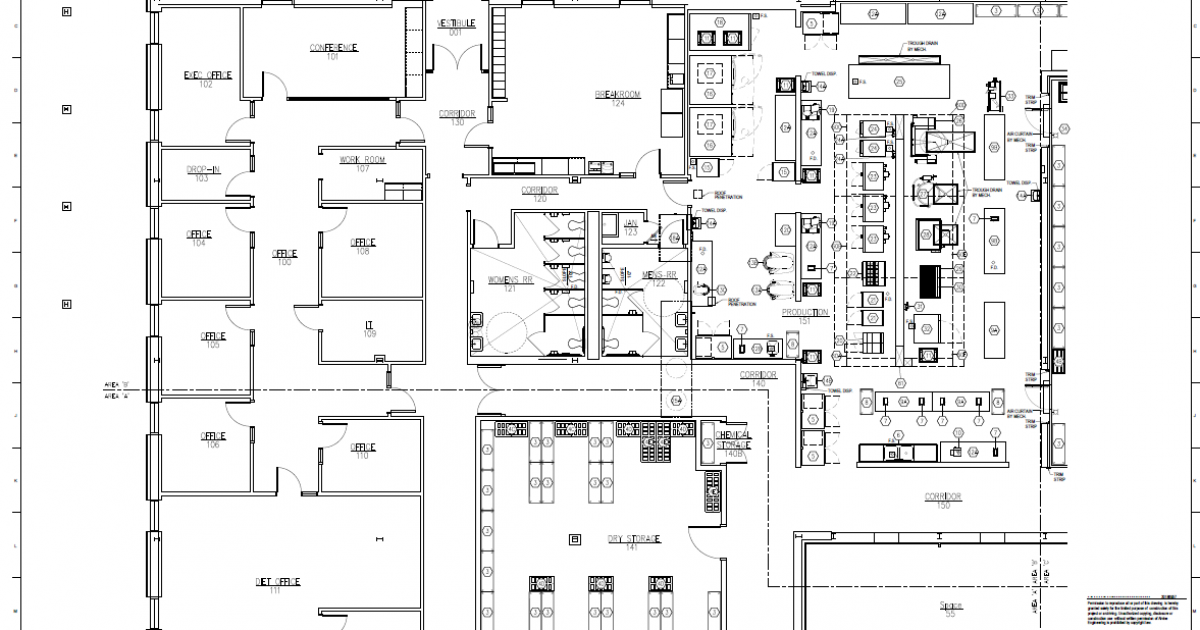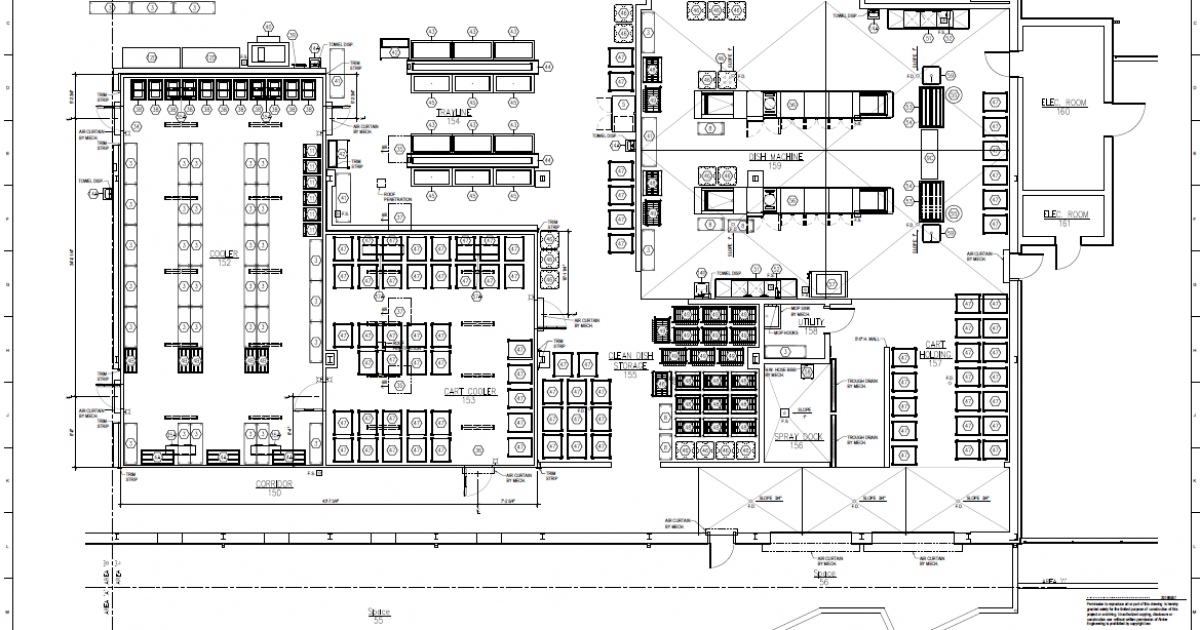Commercial Foodservice Design, Reimagined
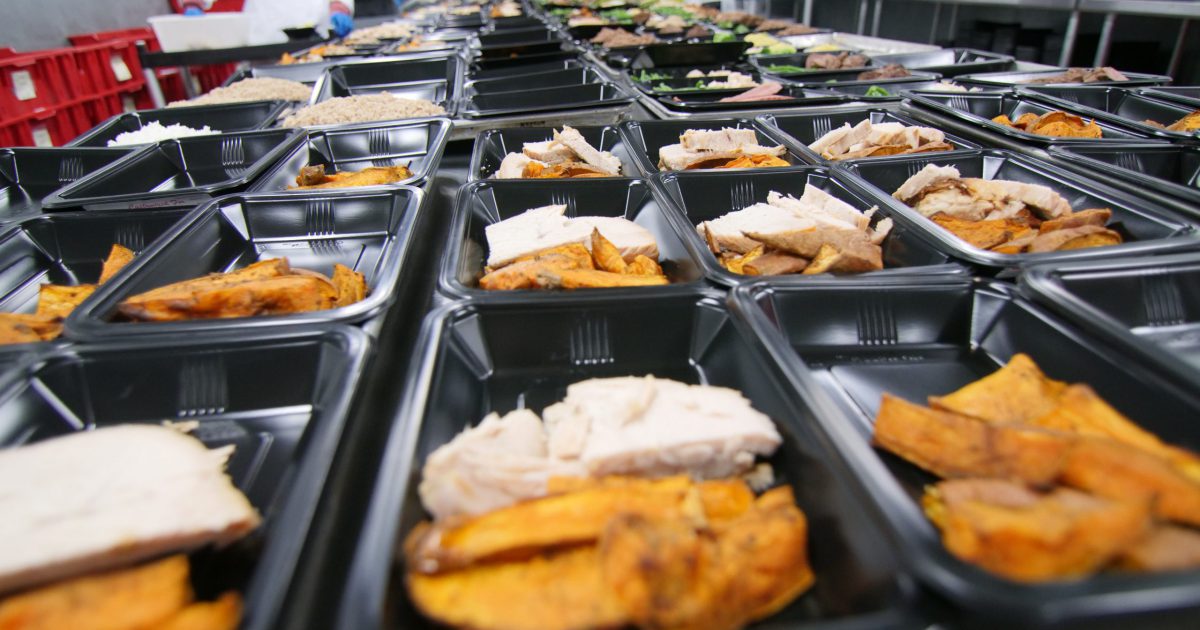
Commercial foodservice design can take place in the most unlikely destinations. A defunct auto repair shop in North Omaha is undergoing a significant metamorphosis to become the epicenter for commercial foodservices for a billion-dollar revenue healthcare organization. The client’s upcoming centralized commercial kitchen will be a multi-faceted improvement for their ever-growing commercial kitchen foodservice needs.
Currently, the client runs its foodservice operations out of a pre-existing medical campus, which has presented several challenges for the healthcare conglomerate. The purpose of the centralized foodservice facility is to generate meals for all of their local venues and hospitals as well as serve out of the campus. One of the client’s initiatives is to provide job creation for the North Omaha community, which depends on the cash flow to help bolster their communal infrastructure. Residents of North Omaha find difficulty in traveling to the current campus, which can be anywhere between a 35-minute to an hour transit by bus. The campus is also becoming overrun with truck traffic and an ever-increasing number of employees. With expanding customer service and communications needs, the requirements necessary to operate the client’s meal distribution strategy were outpacing the space.
Fortunately, the project developer was able to locate a well-suited space in North Omaha. The structure already contained garage bays and easy-to-navigate access roads for truck traffic. All that was left was to retrofit the facility to meet the needs for top-notch commercial kitchen foodservice.
Everything But the Kitchen Sink
Jordon Kramp’s introduction to the project came from the architect, who had an idea about the equipment needed for the space but sought insight into the kitchen’s flow, layout, and design. Jordon Kramp, Alvine Engineering’s Foodservice Consultant and Designer, played a pivotal role in the shape of the facility. Unlike other projects that Jordon had worked on, this development came ready and prepared with a complete equipment list. The next challenge was figuring out how to coordinate the equipment layout without sacrificing the kitchen’s optimal performance potential. The first thing that needed to happen was a significant reduction in the equipment list.
“After initial comparisons of the list and the space, I knew right away that not everything was going to fit,” Jordon explains, “The equipment they wanted was excellent, but it can be difficult for individuals outside of the architectural engineering and construction (AEC) industry to envision how that equipment will fit and flow with the space, which is where I come in.”
Jordon integrated all of the desired equipment into a layout to show the client’s foodservice team the inadequate clearances and other issues they would have encountered had they attempted to include all of the equipment from the list. From there, Jordon and the team collaborated and provided a new list that better fit the space without compromising the facility’s food production capabilities. Jordon emphasized that, throughout the design, the collaboration from architects, engineers, and the client was crucial to bring diverse perspectives that allowed for innovative outcomes.
“A workspace like this has to fulfill a lot of different functions,” Jordon explained, “The design has to be aesthetically pleasing to attract new talent and maintain morale, the layout is integral to productivity and dissuading contamination, and the infrastructure of the building has to be cost-effective.”
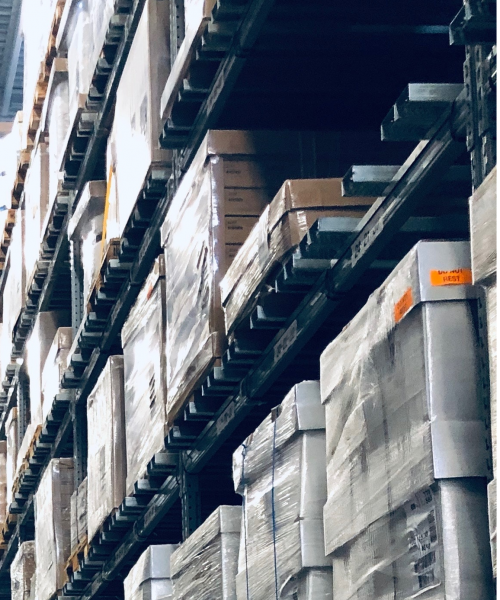
Out with the Old…
The pre-existing mechanical and electrical equipment had to be completely gutted and replaced by brand-new integration. Fortunately, the building’s high ceilings lent themselves well to the bolstered heating, ventilation, and air conditioning (HVAC) integration necessary for a centralized commercial kitchen set to produce hundreds of pounds of food. A majority of the HVAC integration, including air handling units and ductwork, was designated to the roof to save as much space inside the facility for food production. The new HVAC system also includes differing exhaust fans for dishwashers, kitchen equipment, makeup air, and restrooms.
An expansion to the building houses an electrical service room which grants quick and easy access for maintenance crews while also allowing the main facility to prioritize foodservice needs.
“It gave mechanics and repairmen a much better access point to these spaces and allowed them ample room and an ideal space to make repairs.” Jordon stated, “If something were to malfunction, it wouldn’t be in disrepair for long.”
Delivery trucks drop off food supplies and ingredients in the building’s southwest corner neighboring the cold and dry storage areas, an efficient transition site for workers unloading trucks and organizing inventory. The storage areas open up into prep-work stations that work their way up north and brush up against the centrally-located kitchen to the northeast of the storage units. From the kitchen, a central corridor connecting all facility areas feeds into coolers, dishwashing stations, dish storage, utility closets, a spray dock, and a cart storage area. The northwest corner of the building is dedicated to communications and customer support staff, offices, conference rooms, and an adjoining breakroom that bridges the office and food prep areas.
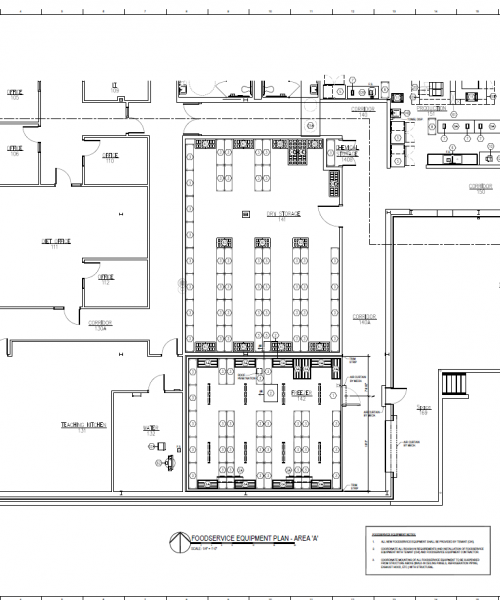
A Chilling Issue Resolved
With the equipment list finalized, Jordon could get to work organizing the space. One of the most critical pillars of foodservice design is optimizing the layout of the structure’s interior to optimize food production workflow and sanitation.
“The workflow is an essential design consideration of any foodservice facility,” Jordon explains, “The layout and flow of food from drop-off, storage, prepping stations, kitchens to send-off determine how quickly you can produce food, how efficient your workforce can be, ease of sanitation, the list goes on. It’s always centered around how things flow to and from the kitchen.”
The team was prepped to finalize the design. However, unforeseen complications within the structure first needed to be addressed.
The cold storage and freezer spaces required strategic placement due to the number of load-bearing support beams inside the facility. Designing cold storage spaces for optimal efficiency relies heavily on the cold space unit’s ability to maintain an insulated seal. The bulk of the power load in commercial kitchens is dedicated to cold storage, making it a vital piece in determining the kitchen’s overall electrical efficiency. Tiles had to be custom-crafted to create a seal around the pillars due to the facility’s anticipated production scale.
Jordon made a point to emphasize the importance of building the cold storage area, especially the freezer space, into the slab of the building. Constructing the freezer into the slab allows smoother transitions for food transportation without workers constantly pushing heavy food carts up and down ramps. It also provides additional space in the cold storage units, and digging into the slab allowed our team to offer a unique design solution to avoid a disastrous issue with the freezer space.
“We provided an insulated slab for both the cold storage and the freezer, and the reason that it was so critical for us to do that is, not only is it beneficial for space and ease of access, a freezer of this size and scale will freeze the ground below,” Jordon explained, “I brought this up to the architect, and we tackled the problem by outfitting the slab with heat tape that had the capability of keeping the ground below the freezer from forming ice.”

Workers in Mind
The inspiration for the commercial kitchen foodservice design was client and worker-focused. Setting up workers for success allows commercial kitchen foodservice to retain talent and optimize workflows and efficiencies. When Alvine Engineering designs for foodservice, it’s essential to look beyond the functionality of the building. The best designs combine how the facility operates and how the occupants engage with the space.
By limiting the time spent walking to and from each station and prioritizing expansive corridors that conveniently feed in and out of all areas, the foodservice design was able to effectively optimize the space to process hundreds of pounds of food throughout the day.
“Keeping workers happy by limiting the amount of energy they have to exert throughout the day is an important factor to consider in foodservice design,” Jordon concluded, “This prevents worker burnout, high turnover rates, and allows for experienced team members to stay on longer, hone their crafts, and provide high quantities of food with better quality assurance.”
Learn more about Jordon Kramp’s foodservice expertise here.

About the Designer
———————————————————————–
Jordon Kramp is a Foodservice Consultant and Designer with over 19 years of industry experience. Jordon specializes in foodservice workflow, equipment layouts, and owner/architect technical document presentation. Jordon has built a diverse portfolio of foodservice designs ranging from restaurant renovations to large-scale stadium concession design.


